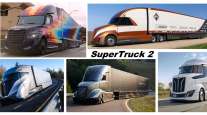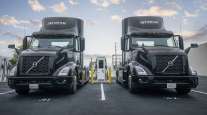Senior Reporter
Volvo Trucks Says SuperTruck II Exceeds Efficiency Goals

[Stay on top of transportation news: Get TTNews in your inbox.]
After nearly seven years of research and development, officials with Volvo Trucks North America said Oct. 10 that its fuel efficient SuperTruck II significantly outperformed the freight and fuel efficiency goals that were put in place with its partner, the U.S. Department of Energy.
Volvo plans to put the new truck on display for the first time publicly at American Trucking Associations’ Management Conference & Exhibition in Austin, Texas, Oct. 14-17.
The futuristic truck is the result of a multiyear collaborative research and development project conducted by several original equipment manufacturers, engine maker Cummins Inc. and other industry partners under the SuperTruck II program co-funded by the Department of Energy.
“Partnering with the DOE for the SuperTruck program provides an exciting opportunity to push the technology envelope to see what’s technically possible for heavy-duty transportation and which solutions can be scaled into production, but equally important, which solutions don’t work for scaled production,” Volvo Trucks North America President Peter Voorhoeve said. “We are extremely proud of the accomplishments of our advanced engineering team who worked on SuperTruck II. A program of this magnitude pushes the limits in every possible area — creativity, problem solving, feasibility and innovation, to which we feel we did successfully. Some of the technologies on SuperTruck 2 will most certainly shape the future of trucking and change everything we once thought possible.”
When the @ENERGY presented a challenge, we rose to the occasion. Meet #VolvoSuperTruck2. A live innovation lab designed for the future. It’s the most aerodynamic tractor trailer system we have ever built, with a 134% increase in freight efficiency. https://t.co/XdqsC3UvwS pic.twitter.com/4PonsIRVgU — Volvo Trucks North America (@VolvoTrucksNA) October 10, 2023
As part of the SuperTruck II program, all of the OEMs that are participating were given the goal of demonstrating a more than 100% improvement in vehicle freight efficiency. Volvo said its truck exceeded that goal by 120%, which is relative to the 2009 baseline; and the truck achieved a 134% improvement, under what it said was the real-world demonstrator validation.
Volvo said it made this improvement by making significant changes to the truck’s aerodynamics.
As a result, the entire tractor-trailer combination was designed by the engineering team to smoothly displace air with minimal resistance, resulting in what they said is a 50% lower drag than Volvo Trucks’ 2009 baseline.
The cab is a wedge shape from front to back with a raked and wraparound windshield. The front end of the truck is designed with what Volvo said is a downsized cooling system. The aerodynamic trailer has gap fairings, skirts and a boat tail as well as an adjustable ride height.

Voorhoeve
Volvo replaced the traditional hood- and cab-mounted mirrors with a streamlined camera monitoring system to cut drag by more than 4%.
Volvo says the SuperTruck II is significantly lighter, with a reduced curb weight now at 27,000 pounds, for both the combined tractor and trailer. The truck utilizes a 4x2 configuration, which is not common in the United States but is frequently seen in Europe. By utilizing fewer axles for the same payload, Volvo said this can be applied to a 6x2 or 6x4 setup.
The company says the combination of improved aerodynamics and reduced weight along with an aluminum chassis that uses a lightweight optimized drive axle system with a single composite driveshaft is a significant step forward in overall truck design.
Both the tractor and trailer use lightweight, smaller, low-friction 19.5-inch tires.
In another effort to reduce energy consumption, Volvo said the 48-volt micro hybrid system acts as a generator that includes an integrated starter, which provides power for the truck’s operating system, driver comfort features and the all-electric HVAC system that reduces idling during rest breaks and still allows for the use of amenities.
“The project team deliberately focused on driving in real-world conditions for testing. Data wasn’t just gathered in a lab or on flat, empty roads with optimal conditions and a light load. Instead, our SuperTruck II was tested in real-world scenarios on roads with traffic and elevation changes with a gross combined vehicle weight of 65,000 pounds,” continued Voorhoeve.
Want more news? Listen to today's daily briefing above or go here for more info
The SuperTruck programs were launched by the Department of Energy in an attempt to improve the efficiency of heavy trucks. SuperTruck I was launched in 2009, with Daimler Truck, Volvo Trucks, Navistar and a joint effort between Cummins and Peterbilt comprising the four teams that worked on various priorities — including improved aerodynamics.
SuperTruck II was launched in 2016.
“This is the most aerodynamic and efficient truck Volvo has built to date, and we achieved a freight efficiency that demonstrates the potential for technology innovations to be developed commercially. Our engineers have already begun implementing some of the learnings from SuperTruck II into our future truck models,” Voorhoeve said. “The future of trucks is just around the corner.”





